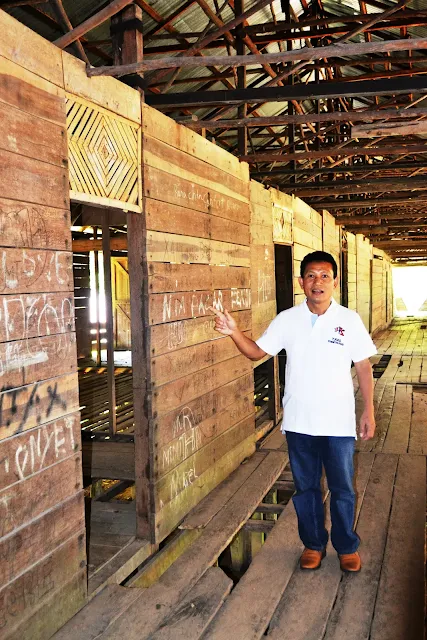If the Longhouse of Kopar Could Cry Out : SOS for Help!
 |
| Author in the longhouse of Kopar, which is threatened with destruction. |
If the longhouse of Kopar could cry out
My recent visit to Sarawak, where I explored four longhouses inhabited by the Dayak Iban people, highlighted the resilience of traditional practices in the face of modern challenges. However, the situation in Kalimantan presents a stark contrast, revealing a broader issue that ties together cultural preservation with the health of the Borneo rainforest.
In Sarawak, the longhouses are not just architectural marvels but symbols of a lifestyle deeply rooted in the ecological balance of the Borneo rainforest. These longhouses, central to the Dayak Iban community, continue to embody a communal living arrangement that respects and integrates with the natural environment.
The Dayak people have long understood the importance of living in harmony with their surroundings, managing their land sustainably while preserving the rainforest's rich biodiversity.
However, the picture in Kalimantan, Indonesia, tells a more troubling story.
As I traveled from Sanggau to Kopar, I observed the encroachment of vast palm oil plantations into what were once lush, biodiverse rainforests. This transformation of the landscape underscores a significant environmental issue: the rapid deforestation and degradation of the Borneo rainforest, which is one of the most ecologically significant areas in the world.
The Borneo rainforest is renowned for its incredible biodiversity, home to thousands of plant and animal species, many of which are endemic and endangered. Yet, this rich ecosystem is under severe threat due to the expansion of palm oil plantations, illegal logging, and other forms of deforestation.
The palm oil industry, driven by global demand, has led to large-scale clearing of rainforests to make way for monoculture plantations. This not only destroys critical habitats but also contributes to climate change by releasing large amounts of carbon stored in the forest biomass.
In Kopar, the traditional longhouse, once a center of communal life, is increasingly overshadowed by these plantations. The vast palm oil estates surrounding the village are a stark reminder of the environmental changes that have taken place.
The loss of longhouses and traditional practices
The shift from traditional, sustainable land use to large-scale monoculture agriculture reflects broader ecological impacts, including soil degradation, loss of biodiversity, and disruptions to the water cycle.
The issue of deforestation in Borneo is emblematic of a larger, global environmental crisis. The destruction of rainforests has far-reaching consequences beyond the immediate loss of trees. It affects global climate patterns, disrupts local weather systems, and endangers the livelihoods of indigenous communities who rely on the forest for their sustenance and cultural practices.
The loss of longhouses and traditional practices in Kalimantan is intertwined with these ecological changes, as the degradation of the environment diminishes the resources and space needed for traditional ways of life to flourish.
Adan, a member of CU Lantang Tipo, provided a personal perspective on the intersection of modern financial practices and traditional lifestyles. His experience with CU loans, which enabled him to renovate his home and expand his business, highlights how economic tools can support adaptation in the face of environmental changes. However, the broader context of deforestation and ecological degradation underscores the challenges that even well-intentioned financial and developmental efforts face when operating within a rapidly changing environment.
The palm oil plantations that now dominate the landscape around Kopar are a visible sign of the global demand for products derived from the rainforest.
The expansion of these plantations reflects not only economic trends but also deep-seated issues related to land use, environmental regulation, and global consumer behavior.
Efforts to mitigate these impacts require a multifaceted approach that includes stronger environmental regulations, sustainable land management practices, and increased awareness about the consequences of deforestation.
Cultural preservation and environmental stewardship
As I reflected on my journey, the connection between cultural preservation and environmental stewardship became increasingly clear. The decline of traditional longhouses in Kalimantan, alongside the destruction of the Borneo rainforest, represents a loss of both cultural and ecological heritage.
 |
| The decline of traditional longhouses in Kalimantan, alongside the destruction of the Borneo rainforest, represents a loss of both cultural and ecological heritage. |
Addressing these issues requires a concerted effort to balance development with conservation, ensuring that both the environment and the traditional ways of life are preserved for future generations.
In conclusion, the fate of the longhouses in Kalimantan is intrinsically linked to the broader environmental challenges facing the Borneo rainforest.
The ongoing deforestation and expansion of palm oil plantations highlight the urgent need for sustainable practices that protect both cultural heritage and ecological systems.
By understanding and addressing these interconnected issues, we can work towards a future where both the natural world and traditional cultures can thrive together.
-- Masri Sareb Putra, M.A.






